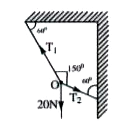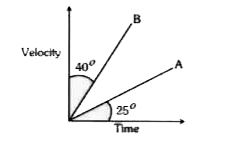In the figure shown the acceleration of A is, →a=15ˆi+15ˆj then the acceleration of B is: (A remains in contact with B)
 Solution in Telugu
Solution in Telugu
6ˆi
−15ˆi
−10ˆi
−5ˆi
The correct Answer is:D
Step by step video & image solution for In the figure shown the acceleration of A is, veca =15hati+15hatj then the acceleration of B is: (A remains in contact with B) by Physics experts to help you in doubts & scoring excellent marks in Class 11 exams.
Updated on:21/07/2023Topper's Solved these Questions
- NEWTONS LAWS OF MOTION BOOK - AAKASH SERIESCHAPTER - NEWTONS LAWS OF MOTION EXERCISE - ADDITIONAL PRACTICE EXERCISE (LEVEL - I (MAIN)) (Straight Objective Type Questions)
26 Videos
- NEWTONS LAWS OF MOTION BOOK - AAKASH SERIESCHAPTER - NEWTONS LAWS OF MOTION EXERCISE - ADDITIONAL PRACTICE EXERCISE (LEVEL - II (LECTURE SHEET (ADVANCED)) (Straight Objective Type Questions)
12 Videos
- NEWTONS LAWS OF MOTION BOOK - AAKASH SERIESCHAPTER - NEWTONS LAWS OF MOTION EXERCISE - PRACTICE SHEET (EXERCISE - IV) (LEVEL - I) (Straight Objective Type Questions)
10 Videos
- MOTION IN A STRAIGHT LINEBOOK - AAKASH SERIESCHAPTER - MOTION IN A STRAIGHT LINEEXERCISE - Questions for Descriptive Answers
7 Videos
- OSCILLATIONBOOK - AAKASH SERIESCHAPTER - OSCILLATIONEXERCISE - QUESTIONS FOR DESCRIPTIVE ANSWERS
12 Videos
Similar Questions
A vehicle of mass 120kg is moving with a velocity of 90kmph. What force should be applied on the vehicle to stop it in 5s. =
View SolutionA lift of total mass M is raised by cables from rest through a height h . The greatest tension which the cables can safely bear is n Mg. The maximum speed of lift during journey if the ascent is to made shortest time is :
View SolutionIf 'O' is at equilibrium then the values of the tension T, and T, are x, y, if 20 N is vertically down. Then x, y are

View SolutionThree tortoises are located at the vertices of an equilateral triangle whose side equals a They all start moving simultaneously with velocity v constant in modulus with the first tortoise heading continually for the second , the second for the third and the third for the first . They will meet after time
View SolutionThe spring shown in figure is unstretched when a man starts pulling on the cord. The mass of the block is M. If the man exerts a constant force F, find the amplitude and the time period of the motion of the block.

View SolutionIn the figure shown the accelerationof A is a_(A) = (15 hati + 15 hatj) . Then the acceleration of B is (A remain in contact with B)
View SolutionIn the situation as shown in the figure if acceleration of B is a, then find the acceleration of A ( B always remain horizintal),
View SolutionIn the figure shown the acceleration of A is, vec(a)_(A) = 15 hat (i) + 15 hat (j) then the acceleration of B is (A remains in contact in B)
View SolutionIn the figure find the velocity and acceleration of B, if instaneous velocity and acceleration of A are as shown in the Fig.
View SolutionIn an arrangement shown in the figure, the acceleration of block A and B are given-
View SolutionIn the figure shown the acceleration of A is, bara_(A)=(15hati+15hatj)m//s^(2). If A is sliding on B then the acceleration of B is.
View SolutionConsider the situation shown in the figure.

Find acceleration of B.
View SolutionIn the arrangement shown in figure, if the acceleration of B is overline(a) , then find the acceleration of A
View Solutionदो कण A और B के लिए वेग समय आरेख चित्र में प्रदर्शित किया गया है। तब A और B का त्वरण होगा

View SolutionAcceleration of A in the image shown veca(A) = 15hati + 15hatj , Then the acceleration of B will be: (A remains in contact with B.)
View Solution
